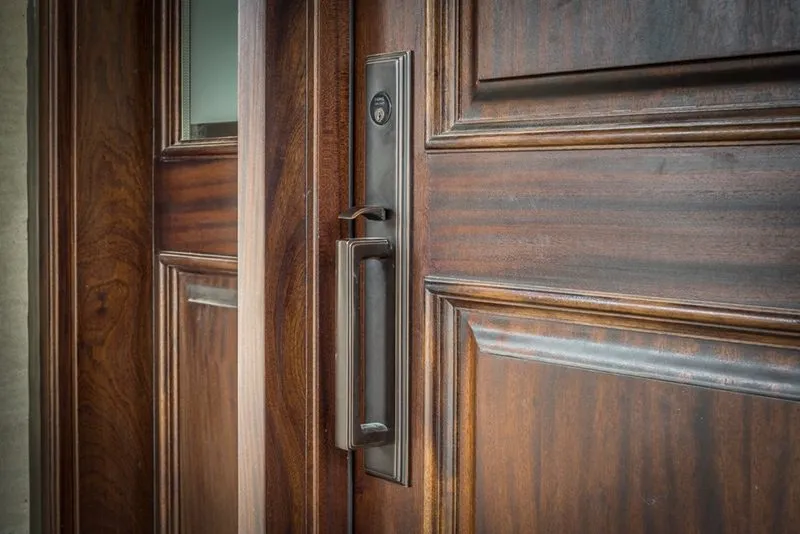Varnished or oiled doors are the most vulnerable and need regular care; even one coat of finish can minimise damage.
Front doors are expensive to replace, and not something you want to do regularly. Follow these simple steps to protect your wooden door from the hot summer sun. A proper paint or varnish job is the key to long-term protection and beauty.
- First, you want to lightly sand down the door and give it a good wipe down. Scrape to remove any loose or peeling paint or varnish.
- Next, apply a coat of varnish or primer that will seal the wood. In the case of a painted door, provide a good surface to caulk or putty to if necessary. In the case of varnish, the wood will have changed colour. If you should opt to putty or patch, you’ll be able to pick a colour that will be close to the finished door.
- In most cases, damaged wood will get darker when sealed. If you feel that stain might be needed, wet the wood with water or solvent before the first coat of varnish. Everything that turns dark with the wetting will get at least that dark when stained. Areas that don’t change colour or change very little will probably react the same way with the stain.
- One or two more coats of the finish enamel or varnish will finish the job.
- Sand lightly between coats to remove any dust or debris that may have stuck to your door.
- If the finish looks a little uneven or partly soaked in, then give the third coat. If it doesn’t change the appearance, then it’s probably a texture difference you see, and additional coats won’t change it much.
Varnished doors should be evaluated every year, especially if they get a lot of sun.
Choosing the Best Exterior Wood Door Protection
Your front door is exposed to sun, wind, and rain every day, which makes protective finishes a key component. Different finishes provide varying levels of durability, appearance, and UV resistance. Here’s a comparison of common options for the best exterior wood door protection:
| Finish Type | Protection Level | UV Resistance | Appearance | Best Use |
| Spar Varnish (Marine) | Excellent | High | Glossy, warm tone | Front doors with direct sun exposure |
| Exterior Polyurethane | Very Good | Moderate–High | Clear, durable | Versatile, good for sheltered doors |
| Penetrating Oil (Tung/Teak) | Good | Moderate | Natural matte finish | Doors with rustic or natural style |
| Paint (Exterior Grade) | Excellent | High | Opaque, customizable | Maximum UV + moisture protection |
According to Fine Woodworking, marine spar varnish is considered one of the best varnishes for wooden front doors, as it expands and contracts with temperature changes while providing excellent UV protection.
How to Seal Your Exterior Wood Door for a Long-Lasting Finish
Sealing your exterior door prevents cracks, fading, and warping. Here’s how to seal an exterior wood door effectively:
- Sand the surface gently to remove old finish or imperfections.
- Clean thoroughly with a tack cloth to eliminate dust.
- Apply a wood conditioner or sealer if the wood is porous (like pine or cedar).
- Use a UV-protective varnish or polyurethane, applying thin, even coats with a high-quality brush.
- Allow proper drying and sanding between coats for a smooth finish.
- Seal all edges (top, bottom, and sides) to prevent moisture infiltration.
By ensuring full coverage, you provide your door with the best exterior wood door protection against sun and seasonal weather.
UV Protection for Exterior Door Finishes: Varnishes, Polyurethane & Oils
UV rays are the leading cause of fading and surface degradation. Using finishes specifically designed for exterior door finish UV protection makes a major difference.
- Spar Varnish: Formulated for boats, it provides maximum UV resistance and flexibility.
- Polyurethane (exterior grade): Great balance of durability and clarity; many versions include UV absorbers.
- Penetrating Oils (like tung or teak oil): Offer natural UV resistance and bring out the grain, though they require more frequent reapplication.
Taking a combination approach, such as applying oil followed by a UV-resistant topcoat, can give you both depth of colour and long-term protection.
Pro Tips for Applying the Best Varnish for Wooden Front Door
- Always apply multiple thin coats instead of one thick layer.
- Use a natural-bristle brush for oil-based varnishes and a synthetic brush for water-based finishes.
- Work in a shaded area to prevent premature drying and brush marks.
- Don’t forget the edges and underside of the door, which are highly vulnerable to moisture.
- Recoat every 12–24 months, depending on sun exposure.
Following these steps ensures your finish maintains both its appearance and protective properties.
Seasonal Maintenance for Front Doors to Protect from Sun Damage
Even the best finish requires routine care. Here are seasonal tasks to extend the life of your wooden door:
- Spring: Inspect for cracks, reapply sealer to edges if needed.
- Summer: Clean monthly with a damp cloth to remove dust and pollen.
- Fall: Apply a protective wax or polish for added resistance.
- Winter: Ensure weatherstripping and seals are intact to keep moisture out.
Routine maintenance prevents small issues from becoming costly repairs and keeps your door beautiful year after year.
Damaged to the point of no repair, we can help
Master Doors has hundreds of standard options to choose from in a variety of wood species, sizes, and glass options. We have everything from wood front doors, solid wood exterior doors and custom entry doors. Browse through our website for the latest elegant styles available for your picking.
FAQ's
What is the best exterior wood door protection against sun damage?
The best protection is a marine spar varnish or high-quality exterior polyurethane with UV absorbers. These finishes create a flexible and durable shield that resists fading and cracking.
How do I seal an exterior wood door effectively?
To seal an exterior wood door, sand the surface, apply a sealer or conditioner, and finish with multiple coats of UV-resistant varnish or polyurethane. Be sure to coat all edges for complete protection.
Which is the best varnish for wooden front doors with UV protection?
Spar varnish (marine-grade) is the gold standard for the best varnish for wooden front doors. It resists UV rays, moisture, and temperature changes, which makes it ideal for doors in direct sunlight.
How do I protect my front door from sun and heat?
Use a UV-protective finish, keep the door shaded with awnings or overhangs, and clean it regularly to prevent buildup that accelerates wear. Seasonal recoating ensures long-term resilience.
How often should I reapply finish to an exterior wooden door?
Typically every 1–2 years for doors exposed to direct sun, and every 3–5 years for sheltered doors. Inspect the finish annually. If it looks dull or faded, it’s time for a new coat.
Are spar varnish and marine varnish better than polyurethane for doors?
Yes, for doors in harsh sunlight or high-humidity areas, spar or marine varnishes outperform polyurethane. However, polyurethane is an excellent choice for partially sheltered doors or those needing a clearer finish.
Can I use an indoor finish on my front door?
No. Indoor finishes lack the UV protection and flexibility needed for exterior conditions. Always use finishes labelled for exterior use to prevent peeling and cracking.
Is an oil-based or water-based finish better for exterior doors?
- Oil-based: More durable, richer colour, better suited for extreme climates.
- Water-based: Dries faster, resists yellowing, and is eco-friendlier. Both can provide excellent results if rated for exterior use.
How do I know when my door finish needs redoing?
Signs include fading colour, dullness, peeling, or fine cracks. If water no longer beads on the surface, your door has lost its protective layer and needs refinishing.
What’s the best way to prep a door before finishing?
Remove hardware, sand the surface smoothly, clean off dust, and use a tack cloth before applying sealer or finish. Proper prep ensures the finish adheres evenly and lasts longer.
What is the best exterior wood door protection against sun damage?
The best protection is a marine spar varnish or high-quality exterior polyurethane with UV absorbers. These finishes create a flexible and durable shield that resists fading and cracking.
How do I seal an exterior wood door effectively?
To seal an exterior wood door, sand the surface, apply a sealer or conditioner, and finish with multiple coats of UV-resistant varnish or polyurethane. Be sure to coat all edges for complete protection.



